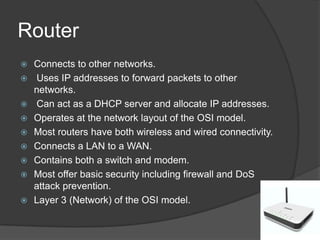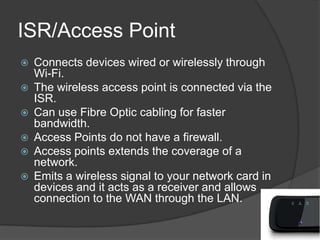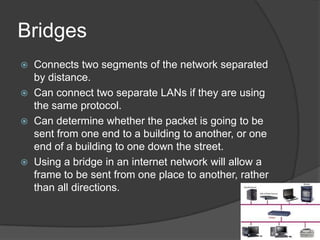Interconnecting Devices
- 2. Hub ï Cannot read Mac Addresses ï Connects segments of the local Network ï Messages sent from one host will be broadcasted to all hosts and not to one specific address. ï Commonly used in LANs. ï Does not manage or examine any of the traffic that goes through it. ï Commonly has 4 ports. ï Layer 1 (Physical) of the OSI model
- 3. Switch ï Can read Mac Addresses so when a frame is sent, it will know which specific host it is directed to. ï Switches cannot connect to wireless devices. ï Switches allow greater bandwidth across the network. ï Commonly used in larger business environments. ï Connects multiple segments of the local network or can create individual sub networks. ï Uses MAC addresses to forward a frame in a network. ï Uses destination MAC addresses to locate the target host. ï Layer 2 (Data link) of the OSI model.
- 4. Router ï Connects to other networks. ï Uses IP addresses to forward packets to other networks. ï Can act as a DHCP server and allocate IP addresses. ï Operates at the network layout of the OSI model. ï Most routers have both wireless and wired connectivity. ï Connects a LAN to a WAN. ï Contains both a switch and modem. ï Most offer basic security including firewall and DoS attack prevention. ï Layer 3 (Network) of the OSI model.
- 5. ISR/Access Point ï Connects devices wired or wirelessly through Wi-Fi. ï The wireless access point is connected via the ISR. ï Can use Fibre Optic cabling for faster bandwidth. ï Access Points do not have a firewall. ï Access points extends the coverage of a network. ï Emits a wireless signal to your network card in devices and it acts as a receiver and allows connection to the WAN through the LAN.
- 6. Mac Addresses ï Defines the host connecting to a network. ï Each host has itâs own unique MAC address ï On a network, Mac filtering can be enabled to increase security. ï They are assigned by the deviceâs manufacturer. It is assigned to the hardware. ï They are 48 bits long, 12 digits hexadecimal. ï When information is sent across the network, the ARP matches the IP address to the correct MAC address. ï The first 3 pairs are what defines the company that made the hardware. e.g. 0C â 0C â 0B â 14 â CD - 98
- 7. Bridges ï Connects two segments of the network separated by distance. ï Can connect two separate LANs if they are using the same protocol. ï Can determine whether the packet is going to be sent from one end to a building to another, or one end of a building to one down the street. ï Using a bridge in an internet network will allow a frame to be sent from one place to another, rather than all directions.






